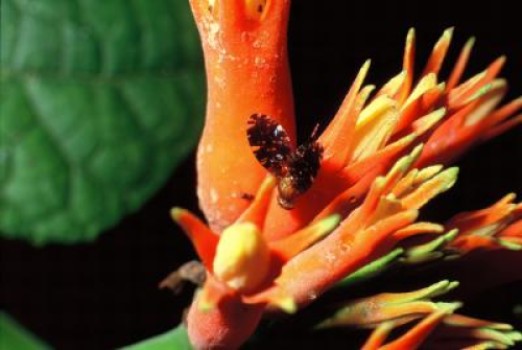Science News
Ridiculously Diverse Insects
March 18, 2014
by Molly Michelson

“Insects are more diverse than we thought—they’re ridiculously, extraordinarily diverse.”
That’s Andrew Forbes of the University of Iowa and he’s not exaggerating! Wikipedia gives the numbers:
The number of extant [insect] species is estimated at between six and ten million, and potentially represent over 90% of the differing animal life forms on Earth.
But Forbes is getting at something else. He and Marty Condon, from Cornell College, surveyed two different species of climbing squashes (cucurbits) in Peru, sampling over 3,000 flowers, male and female, from only the two species. Using genetic testing, Condon and Forbes identified 14 different species of flies and 18 different species of parasitic wasps living on the flowers.
“We looked at species of flies and wasps on two rainforest plants and found more species than theory predicts we should have found,” Condon says. The flies are found nowhere else but these two flowers, writes Ed Yong in National Geographic, “Most were even restricted to either the male or female flowers of their chosen plant.” Talk about being specific—or having a niche, as biologists like to say.
But wait, there’s more…
Most of the 18 parasitic wasps target only one of those 14 different species of fly! We’ve written about these evil-doers (parasitic wasps) before—how they lay eggs on the host, which eventually hatch and kill their victims. But these Peruvian squash flower wasps are particularly interesting. While their larvae will likely only survive in one of the 14 fly species, they will try to lay their eggs in all of them. A “Perspective” editorial in Science magazine provides the details:
The fly larvae are attacked by tiny wasps, a few millimeters in length, that lay their eggs in young larvae. The eggs hatch and the wasp larvae remain in a state of suspended development until their hosts become full grown, when they resume growth and kill them. During the developmental hiatus, the host can fight back by mounting an immunological defense that, if successful, kills the internal parasitoid.
“The reason so many species co-exist appears to be that each fly has a very specialized ability to escape all but one parasitic wasp species, and each wasp has a very specialized ability to kill one specific fly species,” Forbes explains. “Specialized interactions between species allow more species to live in the same place.
“So if you specialize in eating some plants, there shouldn’t be lots of other similar insects eating the same plants. But we’re finding lots and lots of fly species and lots and lots of parasitic wasp species in the same place.”
The team describes how the wasps’ niche with specific flies influences the flies’ niche with specific flowers. “It’s not just a two-dimensional jigsaw puzzle,” Condon says. The team says what they thought was a very strange case of niches overlapping actually ended up broadening the definition of the niche. The study is published in the recent edition of Science.
Ridiculous!
Image: Marty Condon